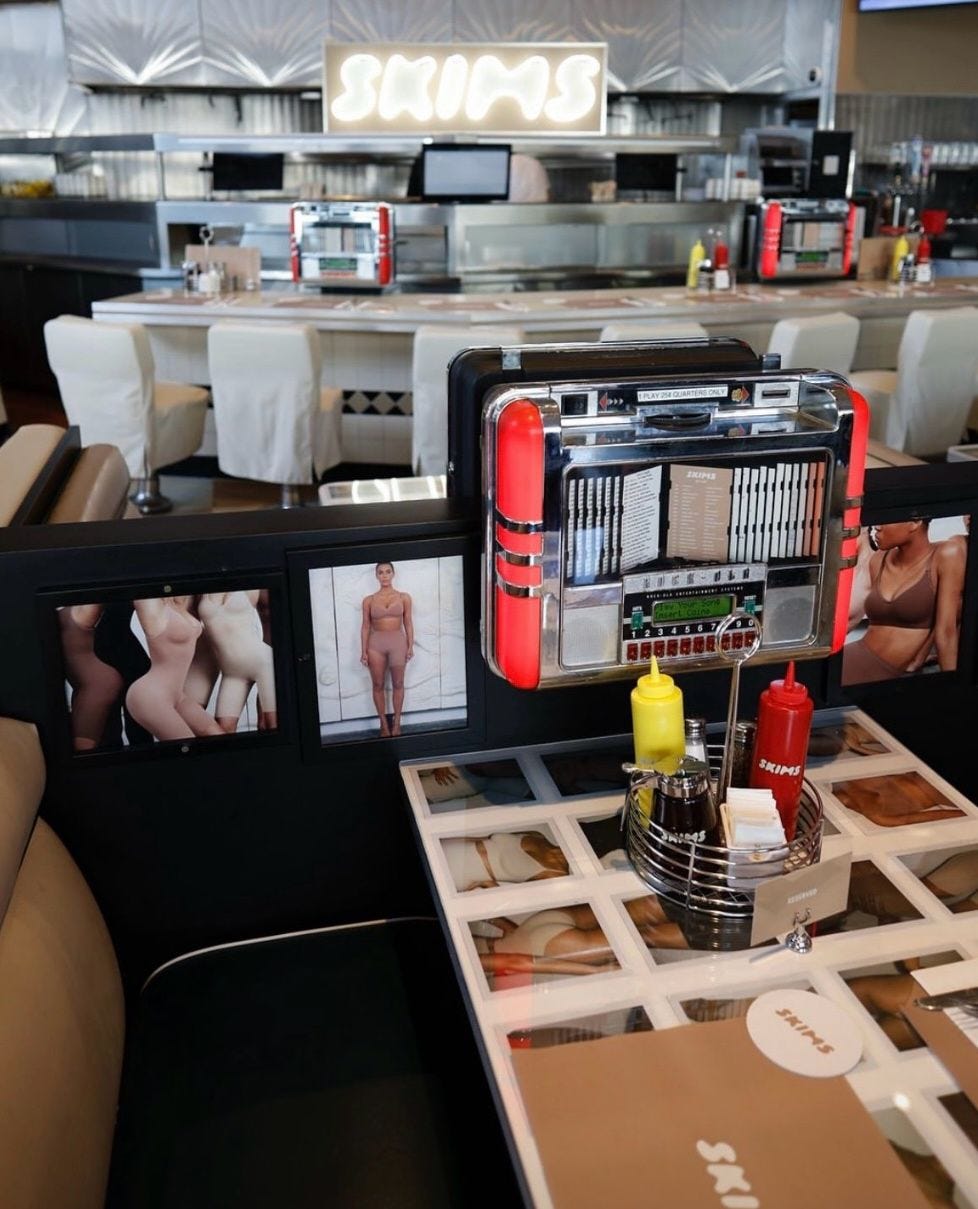Having observed a week of discourse surrounding the SKIMS x Mel's Drive-In activation, I find myself compelled to address what appears to be a collective analytical blindspot in contemporary brand criticism.
The predominant narratives—fixated on metrics of engagement, celebrity attendance, and visual composition—reveal a fundamental misapprehension of what is occurring at the intersection of commerce, identity formation, and cultural production.
The Semiotic Shift: From Transaction to Cultural Inscription
What we witnessed on Sunset Boulevard was not merely another experiential marketing activation. Rather, it constituted a sophisticated semiotic intervention—a deliberate inscription into cultural space that transcends conventional frameworks of brand-consumer relationships. SKIMS did not simply appropriate nostalgic Americana; they reconfigured it as a vessel for contemporary identity performance.
The theoretical significance here cannot be overstated. We are observing the transition from what Baudrillard would term second-order simulacra (where signs reference an absent reality) to third-order simulacra (where signs reference only other signs in an endless chain of signification). The diner doesn't reference actual 1950s American dining culture—it references our mediated understanding of that culture, already processed through cinematic representation, filtered through Instagram aesthetics, and recirculated as aspirational content.
Enrollment Theory and the Architectures of Belonging
Contemporary brand strategy has evolved beyond persuasion models predicated on information transfer. What SKIMS demonstrates is the sophisticated application of enrollment theory—where brands function not as providers of goods but as architects of belonging systems.
This represents a paradigmatic shift from transaction-oriented marketing to what we might term "identity infrastructure." The consumer is no longer conceptualized as a decision-making agent evaluating product attributes, but rather as a social performer seeking frameworks within which to enact desirable versions of selfhood.
The diner activation operates as a physical manifestation of this theoretical framework—a stage upon which consumers can perform particular identity configurations that signal their participation in specific social and cultural hierarchies. The critical distinction is that this performance isn't adjacent to the brand; it is the brand.
Gendered Performance and Controlled Indulgence
The semiotic coding of the SKIMS diner merits particular attention through the lens of gender performance theory. It offers a physical embodiment of what Judith Butler might recognize as the ritualized repetition of stylized acts that constitute gender as a performative achievement rather than an ontological given.
The activation brilliantly encapsulates the paradoxical relationship between indulgence and restraint that characterizes contemporary femininity. Drawing parallels to the "Cool Girl" trope articulated in Gillian Flynn's Gone Girl, we observe a spatial manifestation of this contradiction: a setting designed for the appearance of consumption without the messy reality of actual consumption.
This represents what I term "consequence-free performative appetite"—the ability to signal participation in indulgence while simultaneously signaling one's exemption from its effects. The pancakes and milkshakes function not as food but as props in an elaborate performance of femininity that reconciles traditionally incompatible desires: to indulge and to maintain the disciplined body required by contemporary beauty standards.
The genius of the activation lies in its seamless integration of shapewear (the product) into this performance. The shapewear becomes not merely a solution to a problem but an essential component of the performance itself—allowing for the theatrical display of appetite without challenging the underlying requirement for bodily discipline.
Storydoing: From Narrative Text to Experiential Context
The theoretical framework most illuminating here is the transition from storytelling to storydoing—a shift from brand as narrator to brand as context creator. SKIMS does not merely tell a story about contemporary femininity; it creates a space in which particular narratives of femininity can be enacted, documented, and circulated.
This represents a fundamental evolution in how symbolic capital is generated and exchanged. Rather than broadcasting meaning, the brand creates systems in which consumers participate in meaning-making through their own performed actions. The consumer becomes not merely a receiver of brand communication but a co-creator of brand significance through embodied participation.
The physical environment functions as what sociologist Erving Goffman would term a "front stage"—a setting with props and expressive equipment designed to facilitate particular identity performances. The crucial innovation is that this front stage is simultaneously physical and digital, existing both as a literal space and as a template for content creation.
Cultural Capital and Aesthetic Communities
What makes the SKIMS activation theoretically significant is its function as a mechanism for cultural capital accumulation and exchange. The diner serves as a node in what Pierre Bourdieu would recognize as a field of cultural production—a space where symbolic goods are created, consumed, and converted into social distinction.
By participating in the activation (whether physically or through digital engagement), consumers signal their membership in particular aesthetic communities. These communities are defined not by geographic proximity but by shared tastes, references, and cultural codes—what media theorist Zizi Papacharissi might call "affective publics."
The brand thus becomes not merely a provider of products but a curator of taste cultures—a role traditionally reserved for cultural institutions. This represents a profound shift in how cultural authority is distributed and legitimized in contemporary society.
The Theoretical Implications for Brand Strategy
The strategic significance of this approach extends beyond immediate commercial objectives. What SKIMS has constructed is a system for the continuous generation and circulation of symbolic capital—a mechanism through which cultural relevance is maintained without requiring continuous explicit messaging.
This represents what I term "infrastructure branding"—where the brand's primary function is not to persuade but to provide systems within which desirable identities can be performed, documented, and validated. The product becomes secondary to the social and cultural functions the brand enables.
For strategic practitioners, this demands a fundamental reconsideration of core competencies. Success in this paradigm requires expertise not in message construction or media planning, but in cultural anthropology, spatial design, and the orchestration of social performance.
Conclusion: From Product to Place to Paradigm
The SKIMS diner ultimately exemplifies the evolution from brand as product to brand as place to brand as paradigm. What they have created is not merely a temporary retail environment but a conceptual framework for understanding and performing contemporary identity.
This transition—from selling things to selling ways of being—represents not merely a tactical innovation but a theoretical breakthrough in how we understand the relationship between commerce, culture, and identity formation in late capitalism.
The question for brands is no longer what story to tell, but what worlds to build—what frameworks for identity performance to architect, and what social and cultural functions to enable. This is no longer marketing as persuasion; it is marketing as infrastructure for social being.
Those still optimizing for traditional metrics of engagement and reach are playing a fundamentally different game than what is actually occurring in the spaces where cultural value is being created and exchanged.
The diner wasn't about pancakes. It wasn't even about shapewear. It was about the provision of identity resources in an increasingly fluid cultural landscape.
And the brands that understand this will be the ones that matter in the decade ahead.
Subscribe for more analyses at the intersection of brand theory, cultural studies, and contemporary identity formation.
#BrandTheory #CulturalSemiotics #PerformanceTheory #IdentityFormation #ExperientialBranding #EnrollmentTheory












Share this post